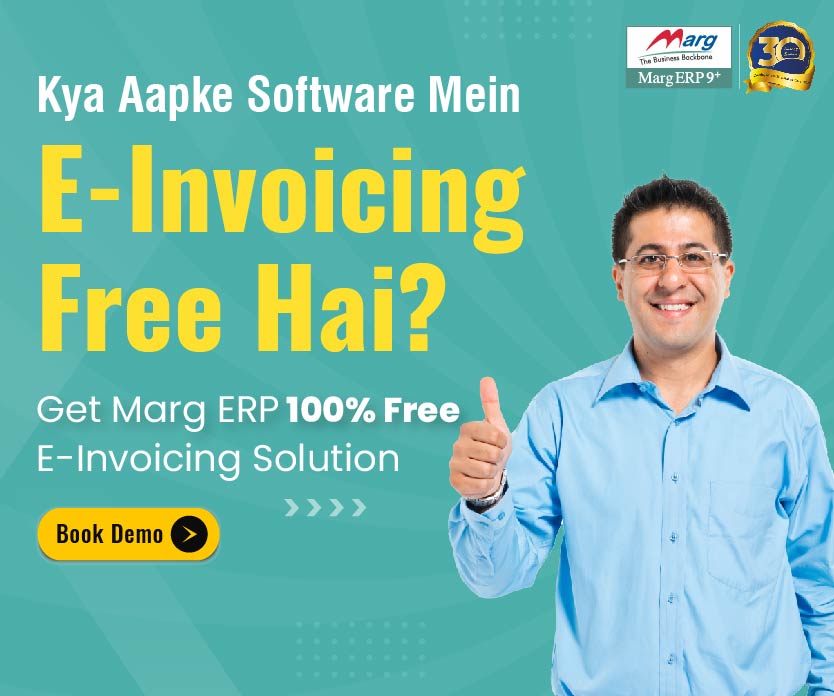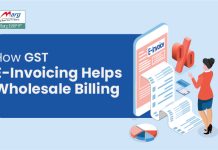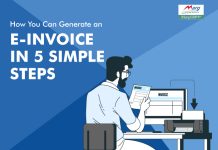Latest update: As per the latest norms, the E-invoicing system is applicable to businesses with an annual turnover of 5 crores and above from 1st Jan 2023. It is mandatory for businesses to create electronic invoices on the government portal.
Article Content
- E-invoicing
- What is e-invoicing?
- How is the current e-invoicing system works?
- E-invoicing Requirements
- E-invoice implementation dates & journey so far
- E-invoicing Registration Process
- Is e-invoice mandatory for export?
- Best e-invoicing software in India
- How to choose the best e-invoicing software in India?
- What are the benefits of choosing Marg ERP?
- Conclusion
E-invoicing
Under the new e-invoicing system, it is mandatory for GST taxpayers to generate e-invoices according to the GST council guidelines. Following the guidelines, you can create GST-compliant invoices. Here’s everything you need to know about GST e-invoicing.
What is e-invoicing?
Electronic invoicing or commonly referred to as e-invoicing is a process of generating invoices electronically as proof of transaction done between the buyer and the supplier and is authenticated by the government tax portal. E-invoicing contains additional information in the form of a QR code.
E-invoicing is a system where the business-to-business (B2B) is electronically generated in a fixed format and is validated by the Goods & Services Tax Network (GSTN).
This system ensures that all the invoices are generated in a common format before submitting them to the GST portal. This system not only makes compliance easy but also ensures transparency in the GST ecosystem.
How is the current e-invoicing system works?
Today, an invoice is generated digitally by the seller and is reported to the GST portal.
Taxpayers generate the e-invoices using different software or GST suvidha providers and upload the details using a suitable API by the taxpayer in the GSTR-1 return. The e-invoices generated through the accounting software are transferred to the IRP i.e.
Invoice Registration Portal in the JSON file format. The government portal then validated the JSON file and return it back after digitally signing it and generating IRN unique reference number. And adding a QR code with more information. The JSON file is then imported into the accounting system & prints the invoice with the QR code.
E-invoicing doesn’t mean generating the invoice through a government portal, it is a process of uploading the invoice in JSON format and downloading it back after validating & digitally signing by the portal.
The same details are auto-populated in GSTR 2A and are made available to the buyer as a view only. Similarly, transporters generate e-way bills either directly or import the invoice into a JSON or excel sheet manually.
Free Download E-invoicing Software
E-invoicing Requirements
According to the norms, e-invoicing must be issued to the IRP in JSON format. The document may include an e-signature. Once the document is submitted to the IRP, IRP validates the e-invoice and returns it back to the supplier after generating a unique reference number and QR code. The following things are required for validating e-invoices:
- Complete data in all mandatory fields.
- Valid GSTIN number of supplier
- Valid GSTIN number of buyer
- Validity of invoice number and financial year.
- Unique identification of the invoice.
E-invoice implementation dates & journey so far
| Sno. | Notification No. | Aggregate Turnover | Effective date |
| 1 | 61/2020 dt 30.07.20 ct | 500 crore | 1/10/2020 |
| 2 | 88/2020 dt 10.11.20 ct | 100 | 1/01/2021 |
| 3 | 05/2021 dt 08.03.2021 ct | 50 | 1/04/2021 |
| 4 | 01/2022 dt 24/02/2022 ct | 20 | 1/04/2022 |
| 5 | 17/2022 dt 01/08 2022 ct | 10 | 1/10/2022 |
E-invoicing Registration Process
Here is the process of how you can register for e-invoicing.
| Go to the invoice registration portal (IRP) -> Click ‘Registration’ |
| You will be redirected to the e-invoice registration form |
| Type your business details, GST & captcha -> Click GO |
| Verify the details that appear like trade name, business name etc |
| Verify and request to send OTP |
| Enter the OTP and click Verify OTP |
| Now enter the username and password of your choice on the dialogue box that appears |
| Re-enter your login credentials & click to Save |
| You can now access the e-invoicing portal using your credntials |
Note: Can create a flow chart diagram here using the above steps
Is e-invoice mandatory for export?
Yes, it is mandatory for every exporter to register on the e-invoicing portal i.e. IRP. At the time of registration, the exporter has to select the type of exports like regular, deemed, supplies from sEZ unit, etc.
Best e-invoicing software in India
Although there are a number of software available in the market for e-invoicing like Marg ERP, Tally Solutions, Buzy, and more but one of India’s most trusted e-invoicing software is Marg ERP.
Marg ERP has all the advanced features necessary for e-invoicing and it is 100% free for e-invoicing. There are no extra hidden charges. As we all know, e-invoicing is mandatory in India for businesses with over 10 crores aggregate turnover, it is advisable to choose software that benefits your business in multiple ways.
How to choose the best e-invoicing software in India?
Now, that we have discussed everything about e-invoicing let’s discuss how to choose the best e-invoicing software in India. To select the best e-invoicing software for your business, you must look for the following features:
- Upload e-Invoice directly from the software
When choosing the right software you must look for an option where you can directly upload multiple invoices to IRP (Invoice Registration Portal) through GSTN portal without visiting any other sources & instantly file GST returns
- Auto- Reconciliation
Another important feature that makes your life easy. You simply need to upload B2B transaction invoices on GSTN portal electronically & the details will get auto-populated in GST ANX-1 and GST ANX-2
- Advance Data Validation
Look for software that automatically validates your data to identify errors, violations, incorrect entries & missing mandatory fields to ensure 100% compliance of legal accuracy
- Generation of QR Code
The software must have the feature of generating QR Code to provide information about a particular invoice, without retrieving from any external sources
- Eway Bill Generation
The software should be able to generate & directly upload Single/ Bulk E-way bills with JSON File on the portal & reconcile automatically
- Track e-Invoices
While using the software, you must ensure that you generate, print and track e-Invoicing in real-time as per the proposed format. The software should provide you with end-to-end assistance for filing GST returns
- No extra charges
Another important thing you should keep in mind is that you must choose software that doesn’t charge extra for generating e-invoices.
Some software might ask for less amount at the installation but may have 15-20 paisa charge per invoice. In the long run, this could result in a heavy expense for your business. Make sure the software your are trying doesn’t have any hidden charges.
You can find all these advanced features in Marg ERP’s E-Invoicing software. Now let us discuss the benefits further. Read Other Useful & Related Content: E-Invoicing Under GST
What are the benefits of choosing Marg ERP?
- Generate E-Invoice directly from the software without going to Portal
- Get 7 Years Cloud Backup
- Print QRcode& IRN on Invoice
- Validate Party GSTIN on Single Click
- Add Digital Signature on Invoice
- Auto error correction
- GSTR 2A/2B Online Reconciliation
- Zero Downtime
- Online E-Way Bill Generation
Conclusion
To wrap the information quickly, I would just like to suggest if you are looking for best e-invoicing software in India for your business, just pick wisely. Get hold of all the pros & cons and then go for it. It is advisable to first take up the trial version before investing.






